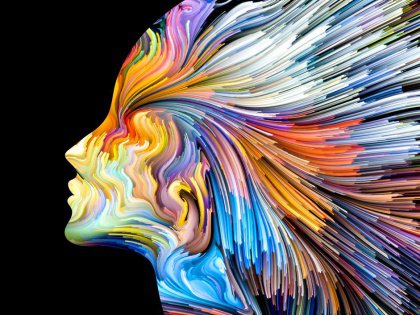Neuro-Linguistic Programming (NLP): What Is It and How Does It Work?

Neuro-linguistic programming (NLP) was created by Richard Bandler and John Grinder in California in the seventies. Its creators claim that there is a connection between neurological processes, language, and learned behavior patterns.
The creators of NLP took three specialists, Fritz Perls, Virginia Satir, and Milton Ericksson, and through various comparative studies, found that these three people possessed special communicational abilities that allowed them to get very good results from their patients.
In this way, they went on to create a collection of tools that would later be called neuro-linguistic programming.
“NLP is like the nuclear physics of the mind. Physics deals with the structure of reality, the nature of the world. NLP does the same thing for your mind. It allows you to break things down into the component parts that make them work.”
-Tony Robbins-
We’ve all reacted to a situation and later our inner voice starts telling us that we should have said something else or reacted in a different way.
In reality, the way we respond and think is conditioned by a neurological map that codifies and stores our ways of responding to a certain situation. That map is made up of our past, our present, and our future, and through it, we create our beliefs, lessons, and learned behaviors.
Our mind’s structures are so strongly embedded in us that we cannot influence them, at least not in a conscious way.
The mind works on two levels: the conscious (logical thought) and the unconscious (automatic functions).

The conscious mind is that which is constantly alert, that which allows us to remember dates and people’s names, for example. And the subconscious mind is the part of the brain that activates all of the behaviors, beliefs, values, etc. that we have learned and which make up our way of acting. It is the part of our mind that allows us to drive, write an email, or open a window.
For our subconscious mind to be able to “draw” a new map, it has to act with a clear objective that responds to the question, “what do we want?”
And the complicated part is precisely that, for we often do not know what we want, we do not know how to define our goal. For this, we must think about something that will really make our habitual behavior in a given situation change, something that is apparently impossible.
“If you want different results, do not do the same things”
–Albert Einstein–
Questions to help us define our goals
Is it a positive goal?
For our programming to work, we must define a positive goal. Our goal cannot start with “I do not want…”
Does it benefit you?
Your goal must be something that you are doing for yourself and which depends on you and not others. For example, it is very common for young people’s goal to be to finish college, but this is not their goal, it is their parents’. Additionally, you must control what you do to achieve your goal so that it will depend on you. We cannot set a goal like the weather being good this weekend, because this does not depend on us.
How will you know that you are achieving it?
Think about what you will be doing at that time and how you will feel. Visualize each action, each feeling that this moment will generate in you, how it will smell, what flavor it will leave in your mouth, what you will hear, how you will move, what you will do. Moreover, to know if we are achieving our goal, we will have to set short-term goals for ourselves and keep track of whether or not we are accomplishing them. For example, if my goal is to find a job, a short-term goal would have to be looking at job offers and applying to something each week.
Is your goal specific?
You have to make it clear what you want and what you don’t. The more defined and detailed your goal is, the easier it will be to establish the steps necessary to achieve it. For example, if we define our goal as “I want to find a job,” it is a very generic goal.
But, if we redefine the goal by giving it detail, we will have much clearer short-term goals to achieve so that we can reach our long-term goal. For example, “starting February 1, 2016, I will work at a company dedicated to computer science and which will pay me 2,000 dollars per month.”
What resources do you need to make it a reality?
Think about the resources that you already have and those you will need in a general way: knowledge, objects, economic resources, help from third parties.
Once we have set our goal, we must review our beliefs and values. What we have firmly embedded in ourselves and which stops us from achieving our dreams. We must change our negative belief structures, the ones that are building obstacles along the way to our goal.
One of the greatest obstacles that we find along the way to our dreams is the opinions of others. Remember that everyone has different perspectives and we must put ourselves in their shoots in an attempt to understand their reasons.
All along the way to your goal, visualize your dream, think about how it will smell, what you will hear, what you will touch, and in particular, the sensation and feeling of happiness that achieving this goal will create in you.
And achieve your dream! Make a reality of your aspiration!
For our subconscious mind to learn a new program that will allow us to make our dreams into a reality, it has to see the reason, the motive.

NLP, the process of learning, is established in four phases
Phase 1: Unconscious incompetence. I don’t know what I don’t know.
Phase 2: Conscious incompetence. I know what I don’t know.
Phase 3: Conscious competence. I know what I know.
Phase 4: Unconscious competence. I don’t know what I know.
To unlearn, we go from step 4 to step 2, and to relearn, from step 2 to step 4.
Once the new program has been learned, we will be able to apply it when it is necessary.
Therefore, NLP helps us to create new mental programs that make many aspects of our lives easier and which help us to work on goals to achieve our dreams and desires.
The greatest development in NLP has been made in interpersonal relationships and the working world. In these two domains, you can use NLP to train your competencies, to overcome the obstacles before you, to resolve conflicts, and to influence other people.
But above all else, NLP gives you the tools you need to control how you respond to the people around you, how you perceive them, and in this way, to take steps towards making your dreams into a reality.
Neuro-linguistic programming (NLP) was created by Richard Bandler and John Grinder in California in the seventies. Its creators claim that there is a connection between neurological processes, language, and learned behavior patterns.
The creators of NLP took three specialists, Fritz Perls, Virginia Satir, and Milton Ericksson, and through various comparative studies, found that these three people possessed special communicational abilities that allowed them to get very good results from their patients.
In this way, they went on to create a collection of tools that would later be called neuro-linguistic programming.
“NLP is like the nuclear physics of the mind. Physics deals with the structure of reality, the nature of the world. NLP does the same thing for your mind. It allows you to break things down into the component parts that make them work.”
-Tony Robbins-
We’ve all reacted to a situation and later our inner voice starts telling us that we should have said something else or reacted in a different way.
In reality, the way we respond and think is conditioned by a neurological map that codifies and stores our ways of responding to a certain situation. That map is made up of our past, our present, and our future, and through it, we create our beliefs, lessons, and learned behaviors.
Our mind’s structures are so strongly embedded in us that we cannot influence them, at least not in a conscious way.
The mind works on two levels: the conscious (logical thought) and the unconscious (automatic functions).

The conscious mind is that which is constantly alert, that which allows us to remember dates and people’s names, for example. And the subconscious mind is the part of the brain that activates all of the behaviors, beliefs, values, etc. that we have learned and which make up our way of acting. It is the part of our mind that allows us to drive, write an email, or open a window.
For our subconscious mind to be able to “draw” a new map, it has to act with a clear objective that responds to the question, “what do we want?”
And the complicated part is precisely that, for we often do not know what we want, we do not know how to define our goal. For this, we must think about something that will really make our habitual behavior in a given situation change, something that is apparently impossible.
“If you want different results, do not do the same things”
–Albert Einstein–
Questions to help us define our goals
Is it a positive goal?
For our programming to work, we must define a positive goal. Our goal cannot start with “I do not want…”
Does it benefit you?
Your goal must be something that you are doing for yourself and which depends on you and not others. For example, it is very common for young people’s goal to be to finish college, but this is not their goal, it is their parents’. Additionally, you must control what you do to achieve your goal so that it will depend on you. We cannot set a goal like the weather being good this weekend, because this does not depend on us.
How will you know that you are achieving it?
Think about what you will be doing at that time and how you will feel. Visualize each action, each feeling that this moment will generate in you, how it will smell, what flavor it will leave in your mouth, what you will hear, how you will move, what you will do. Moreover, to know if we are achieving our goal, we will have to set short-term goals for ourselves and keep track of whether or not we are accomplishing them. For example, if my goal is to find a job, a short-term goal would have to be looking at job offers and applying to something each week.
Is your goal specific?
You have to make it clear what you want and what you don’t. The more defined and detailed your goal is, the easier it will be to establish the steps necessary to achieve it. For example, if we define our goal as “I want to find a job,” it is a very generic goal.
But, if we redefine the goal by giving it detail, we will have much clearer short-term goals to achieve so that we can reach our long-term goal. For example, “starting February 1, 2016, I will work at a company dedicated to computer science and which will pay me 2,000 dollars per month.”
What resources do you need to make it a reality?
Think about the resources that you already have and those you will need in a general way: knowledge, objects, economic resources, help from third parties.
Once we have set our goal, we must review our beliefs and values. What we have firmly embedded in ourselves and which stops us from achieving our dreams. We must change our negative belief structures, the ones that are building obstacles along the way to our goal.
One of the greatest obstacles that we find along the way to our dreams is the opinions of others. Remember that everyone has different perspectives and we must put ourselves in their shoots in an attempt to understand their reasons.
All along the way to your goal, visualize your dream, think about how it will smell, what you will hear, what you will touch, and in particular, the sensation and feeling of happiness that achieving this goal will create in you.
And achieve your dream! Make a reality of your aspiration!
For our subconscious mind to learn a new program that will allow us to make our dreams into a reality, it has to see the reason, the motive.

NLP, the process of learning, is established in four phases
Phase 1: Unconscious incompetence. I don’t know what I don’t know.
Phase 2: Conscious incompetence. I know what I don’t know.
Phase 3: Conscious competence. I know what I know.
Phase 4: Unconscious competence. I don’t know what I know.
To unlearn, we go from step 4 to step 2, and to relearn, from step 2 to step 4.
Once the new program has been learned, we will be able to apply it when it is necessary.
Therefore, NLP helps us to create new mental programs that make many aspects of our lives easier and which help us to work on goals to achieve our dreams and desires.
The greatest development in NLP has been made in interpersonal relationships and the working world. In these two domains, you can use NLP to train your competencies, to overcome the obstacles before you, to resolve conflicts, and to influence other people.
But above all else, NLP gives you the tools you need to control how you respond to the people around you, how you perceive them, and in this way, to take steps towards making your dreams into a reality.
This text is provided for informational purposes only and does not replace consultation with a professional. If in doubt, consult your specialist.







